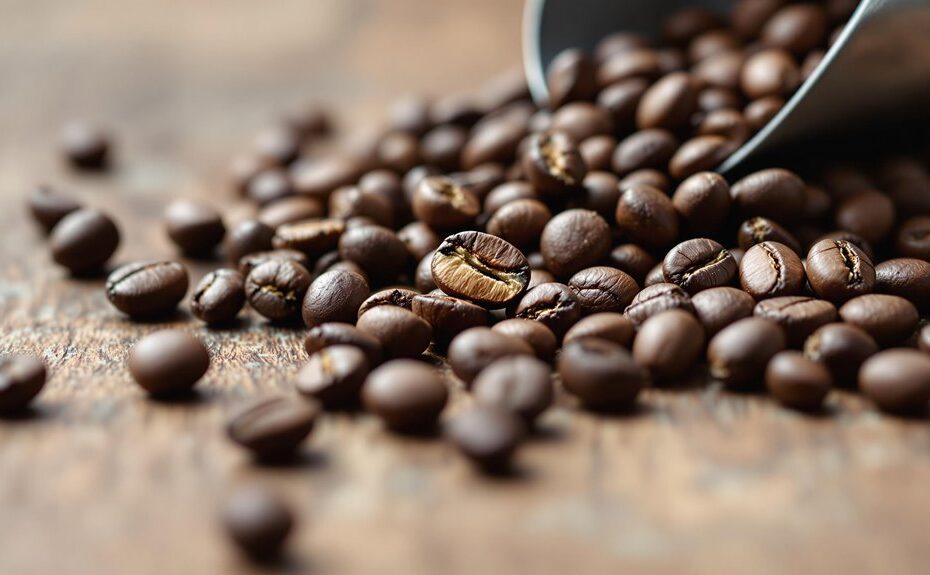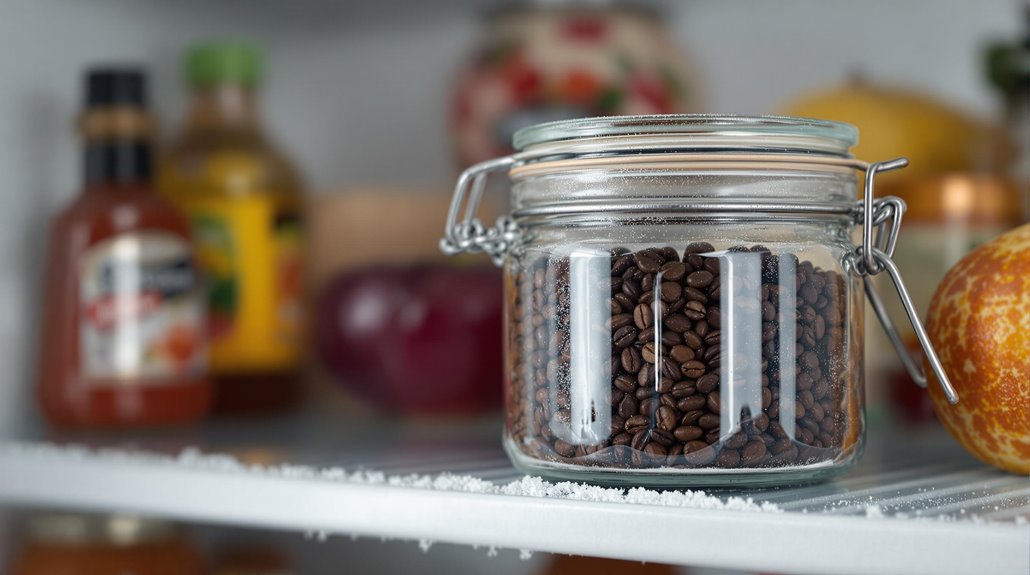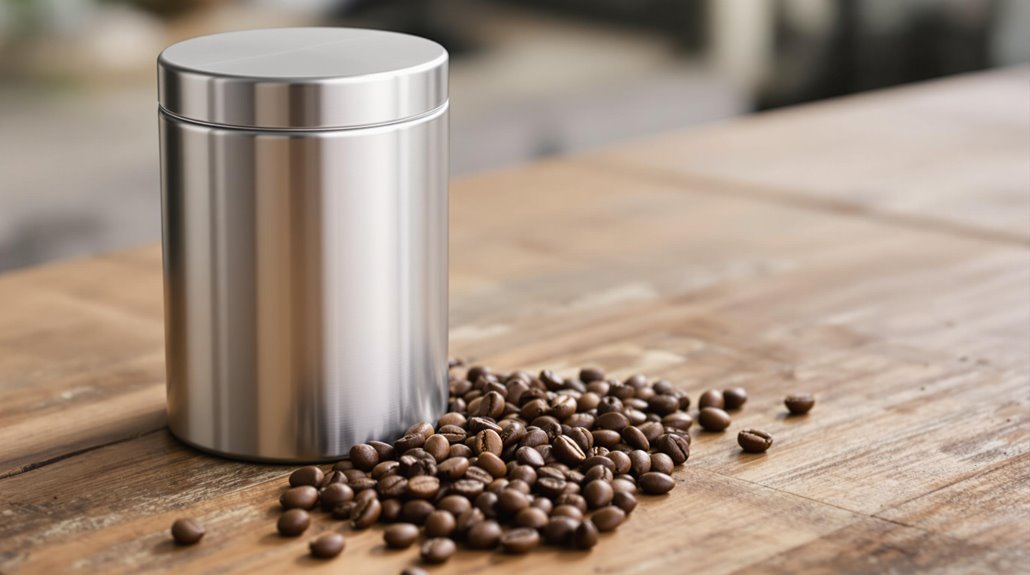







You might think stale coffee is just a minor inconvenience, but it can drastically alter your morning ritual. Start by examining the beans—do they look dull or oily, or have they lost their vibrant sheen? Next, take a whiff; if the aroma feels flat or reminds you of cardboard, that's a red flag. Finally, taste it—does it lack complexity or feel thin on your palate? These subtle signs can reveal more than you'd expect about your coffee's freshness. But what if the problem isn't the beans themselves, but how you're storing them?
Key Takeaways
- Check for a dull, matte appearance and dry, grainy texture instead of a glossy sheen or slight oiliness.
- Smell the coffee: stale coffee has a flat, musty, or cardboard-like aroma instead of vibrant, complex notes.
- Taste the coffee: stale coffee lacks nuanced flavors, tasting flat, bitter, or metallic with a thin, watery mouthfeel.
- Observe clumping in ground coffee or uneven coloration in beans, indicating moisture absorption or oxidation.
- Test freshness by brewing: fresh coffee produces a rich bloom and thick crema; stale coffee shows minimal bloom or thin crema.
Physical Signs of Stale Coffee Beans
When coffee beans lose their freshness, you'll notice distinct physical changes that signal staleness. Fresh coffee beans typically exhibit a glossy sheen, but as they age, this luster fades, leaving a dull, matte surface. If you rub the beans between your fingers, you'll feel a dry, grainy texture instead of the slight oiliness or moisture that indicates coffee beans are fresh. Over time, exposure to air and improper storage can cause the beans to absorb moisture, leading to clumping in ground coffee. This clumping is a clear sign of degradation. Additionally, the roast date on the bag of coffee is a critical indicator; beans stored beyond their peak freshness window often develop uneven coloration, appearing faded or patchy. Darker roasts may become excessively oily, while lighter roasts can dry out completely. These physical transformations are subtle but unmistakable, making it easier to identify when your beans have passed their prime. Always check the roast date and inspect the beans for these visual and tactile cues to guarantee you're brewing with the best quality.
Aroma Changes in Stale Coffee
When coffee goes stale, you'll notice a sharp decline in its aromatic intensity, with vibrant fruity, floral, or nutty notes fading first. Instead of a rich, complex bouquet, stale coffee often emits a flat or dull scent, sometimes accompanied by musty or cardboard-like odors. These off-putting aromas signal oxidation and degradation of the volatile compounds that give fresh coffee its signature fragrance.
Fading Aromatic Intensity
The aromatic intensity of coffee is one of the most immediate indicators of its freshness. When coffee beans are fresh, they release a vibrant, complex bouquet of fruity, floral, or nutty notes that are unmistakable. These volatile compounds, responsible for the aroma, degrade over time, especially once the beans are roasted. Within 2-3 weeks post-roasting, you'll notice a significant decline in the fragrant intensity of your coffee. Stale beans or ground coffee lose their ability to emit those bright, inviting scents, leaving behind a muted or nearly odorless profile.
Fresh coffee beans should have a robust, multi-layered aroma that fills the air as soon as you open the bag. If you detect a flat or faint smell, it's a clear sign the beans are past their prime. The absence of those characteristic aromatic notes—whether citrusy, floral, or earthy—indicates oxidation and staleness. Even if the coffee doesn't yet smell musty or cardboard-like, the fading aromatic intensity alone is a reliable marker that the beans are no longer fresh. Trust your senses; they'll guide you to better coffee.
Musty or Cardboard Odors
One of the most unmistakable signs of stale coffee is the emergence of musty or cardboard-like odors. When coffee loses its freshness, the vibrant fruity, floral, or nutty aromas fade, replaced by dull, papery, or earthy coffee smells. This shift occurs as oxidation breaks down the volatile organic compounds responsible for the coffee's original aroma. Over time, these compounds degrade, leaving behind a musty scent that signals staleness. If your coffee smells like damp cardboard or old paper, it's a clear indicator that it's past its prime. Extremely stale coffee may even develop an ashy or woody aroma, further confirming its deterioration. The musty odor intensifies as the coffee ages, especially after 2-3 weeks post-roasting, when the aromatic compounds dissipate rapidly. To detect these changes, grind a small amount of coffee and inhale deeply—fresh coffee will have a complex, inviting aroma, while stale coffee smells flat and lifeless. Trust your senses; if the aroma lacks depth and reminds you of cardboard or mildew, it's time to replace your beans.
Taste Indicators of Stale Coffee
When your coffee tastes flat and lacks the nuanced layers of acidity, sweetness, or floral notes, it's likely stale. A pronounced bitterness or sharp, unpleasant acidity often signals oxidation, while a metallic or cardboard-like aftertaste confirms the beans have degraded. These taste indicators reveal a loss of freshness and complexity, leaving you with a dull, one-dimensional cup.
Flat, Bitter Flavor
Flat, bitter flavors are a telltale sign your coffee has lost its freshness. When coffee goes stale, its vibrant, complex coffee flavor diminishes, leaving behind a dull, one-dimensional profile. Instead of the bright acidity or nuanced fruity, floral, or nutty undertones you'd expect from fresh beans, stale coffee tastes flat and lifeless. The bitterness often intensifies, overpowering any subtle notes that might remain. This bitterness isn't the pleasant, balanced kind found in well-roasted coffee—it's harsh and lingering, signaling oxidation and degradation of the beans' natural oils and compounds. You might also detect a metallic or papery aftertaste, which further confirms the coffee has gone stale. These sensory changes occur as the aromatic compounds break down over time, especially if the beans are exposed to air, light, or moisture. If your brew lacks the lively, layered flavors you're used to and instead delivers a flat, bitter punch, it's a clear indicator that your coffee is past its prime. Trust your palate—it's your best tool for identifying stale coffee.
Lack of Complexity
Stale coffee's lack of complexity becomes immediately apparent when compared to the vibrant, multi-layered flavors of fresh beans. Good coffee brewed from fresh coffee beans delivers a symphony of tasting notes—fruity, floral, nutty, or chocolatey undertones that dance on your palate. In contrast, stale coffee loses this depth, tasting flat and one-dimensional. You'll notice the absence of those nuanced flavors, replaced by a dull, papery, or cardboard-like aftertaste that lacks richness. The acidity, once bright and balanced, may turn overly sharp or muted, further stripping the brew of its character.
To determine whether your coffee is stale, pay attention to the mouthfeel. Fresh coffee offers a juicy, vibrant texture that coats your tongue, while stale coffee feels thin and watery, failing to deliver the satisfying body you expect. The absence of these sensory markers—complexity, balance, and texture—clearly signals that your beans have lost their freshness. If your cup lacks the intricate layers that define good coffee, it's time to replace your beans.
Metallic Aftertaste
A metallic aftertaste creeping into your coffee is a telltale sign of staleness, often caused by the oxidation of oils and aromatic compounds in the beans. As coffee ages, its organic acids and volatile compounds break down, leading to a sharp, tinny flavor that lingers on your palate. This metallic aftertaste is particularly noticeable in stale coffee that's been exposed to air, light, or heat for extended periods, accelerating the degradation process. The taste is often described as "rusty" or "chemical-like," a stark contrast to the rich, nuanced flavors of fresh coffee. Brewing methods like espresso can intensify this metallic note, making it more pronounced compared to other techniques. If your coffee leaves a lingering, unpleasant tang reminiscent of metal, it's a clear indicator that the beans have lost their freshness. Oxidation not only dulls the coffee's complexity but also introduces off-flavors that dominate the cup. Pay attention to this sensory cue—it's a reliable way to identify stale coffee and guarantee you're brewing with quality beans.
How Storage Affects Coffee Freshness
Proper storage plays a critical role in preserving coffee's freshness by shielding it from environmental factors that degrade its quality. The best way to store coffee is in an airtight container, which minimizes exposure to oxygen. Oxygen triggers oxidation, breaking down the volatile aromatic compounds that give coffee its vibrant flavors and aromas. Without proper sealing, your coffee will lose its complexity, developing flat, stale notes within days.
Light and heat are equally detrimental. Ultraviolet rays from sunlight degrade coffee oils and organic compounds, accelerating staleness. Store your coffee in a cool, dark place, ideally around 20°C (68°F), to maintain its delicate balance of flavors. Humidity is another enemy; moisture absorption alters the coffee's chemical structure, leading to a musty or dull taste.
Whole beans fare better than ground coffee due to their reduced surface area, retaining freshness for 2-3 weeks post-roast. Ground coffee, however, loses its peak flavor within minutes to hours due to increased exposure to air. By controlling these variables, you can substantially extend the life of your coffee's sensory profile.
Best Practices for Storing Coffee Beans
To maintain the vibrant flavors and aromas of your coffee beans, store them in an airtight container that shields them from oxygen, the primary culprit behind oxidation. Opt for a container with a one-way valve, which allows carbon dioxide to escape without letting air in, preserving the beans' freshness. Keep the container in a cool, dark place, ideally between 50-70°F (10-21°C), to prevent heat and light from degrading the delicate oils and compounds that define your coffee's profile. Avoid refrigerating or freezing your beans, as moisture and temperature fluctuations can lead to condensation, which dulls flavor and accelerates staleness. For ideal results, use your coffee within two to three weeks of roasting, as beans lose 60-70% of their aromatic compounds after this period. Purchase whole beans and grind them just before brewing to minimize surface area exposure, ensuring the freshest possible cup. By following these practices, you'll preserve the nuanced notes and rich aromas that make your coffee exceptional.
How to Test Coffee Freshness at Home
With a few simple tests, you can determine whether your coffee beans still hold their freshness or have succumbed to staleness. Start by using your sense of smell: grind a small amount of beans and inhale deeply. Fresh coffee releases a vibrant, aromatic bouquet, while stale coffee emits a dull, musty odor. Next, assess the bloom when brewing. Pour hot water over freshly ground coffee and observe the reaction. Fresh coffee produces a rich, foamy bloom due to CO2 release, whereas stale coffee shows minimal or no bloom. Taste the resulting cup of coffee to evaluate its flavor profile. Fresh coffee delivers a complex, balanced taste with bright acidity and nuanced notes, while stale coffee often tastes flat, overly bitter, or one-dimensional. For espresso, examine the crema. Fresh beans yield a thick, golden layer, while stale beans create a thin, pale crema or none at all. Finally, test freshness over time by sealing whole beans in a ziploc bag overnight. Fresh beans inflate the bag with CO2, while stale beans leave it flat. These methods provide a clear, sensory-driven assessment of your coffee's quality.
Common Mistakes That Lead to Stale Coffee
Several common mistakes can quickly turn your coffee stale, robbing it of its vibrant aroma and complex flavor. Storing coffee in clear containers exposes it to light, accelerating oxidation and causing the coffee to lose its freshness. If you leave coffee bags unsealed, air infiltrates the packaging, leading to rapid flavor degradation. Within days, you'll notice the signs of stale coffee: a flat aroma and muted taste. Grinding beans in advance is another misstep—increased surface area speeds up oxidation, making the coffee go stale faster. Pre-ground coffee is particularly prone to this, as it's already lost much of its freshness before you even open the bag. Storing coffee near heat sources or in humid environments also hastens the breakdown of aromatic compounds, leaving you with bad coffee that lacks depth. To avoid these pitfalls, keep your coffee in airtight, opaque containers away from light, heat, and moisture. By addressing these mistakes, you'll preserve the coffee's integrity and prevent it from going stale prematurely.
Creative Uses for Stale Coffee Beans
Even if your coffee beans have lost their vibrant aroma and nuanced flavor, they can still serve a purpose beyond the brew. Use stale coffee beans in baking recipes like coffee cakes or brownies, where their muted flavor can still impart a rich, earthy depth. For savory dishes, grind them into a coarse powder and mix with spices to create a robust coffee rub for meats, enhancing the caramelized crust during grilling or roasting. If you prefer cold beverages, brew stale coffee beans for cold brew or iced coffee; the cold extraction process minimizes the impact of diminished flavors, resulting in a smoother, less acidic drink.
Stale coffee grounds are equally versatile. Add them to your compost pile to enrich the soil with nitrogen, potassium, and phosphorus, promoting healthier plant growth. Alternatively, repurpose them in DIY beauty treatments. Combine coffee grounds with coconut oil or honey to create an exfoliating scrub that removes dead skin cells while leaving a subtle, earthy scent. For hair care, mix grounds with conditioner to create a volumizing mask that adds texture and shine. These creative uses guarantee your stale coffee beans and grounds don't go to waste.
Disclosure: As an Amazon Associate, I earn from qualifying purchases.





